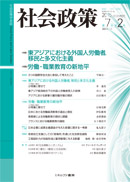Volume 7, Issue 2
Displaying 1-26 of 26 articles from this issue
- |<
- <
- 1
- >
- >|
-
Article type: Cover
2015 Volume 7 Issue 2 Pages Cover1-
Published: December 25, 2015
Released on J-STAGE: February 01, 2018
Download PDF (13322K) -
Article type: Appendix
2015 Volume 7 Issue 2 Pages App1-
Published: December 25, 2015
Released on J-STAGE: February 01, 2018
Download PDF (68K) -
Article type: Index
2015 Volume 7 Issue 2 Pages Toc1-
Published: December 25, 2015
Released on J-STAGE: February 01, 2018
Download PDF (179K) -
Article type: Article
2015 Volume 7 Issue 2 Pages 1-3
Published: December 25, 2015
Released on J-STAGE: February 01, 2018
Download PDF (446K) -
Article type: Article
2015 Volume 7 Issue 2 Pages 5-8
Published: December 25, 2015
Released on J-STAGE: February 01, 2018
Download PDF (435K) -
Article type: Article
2015 Volume 7 Issue 2 Pages 9-26
Published: December 25, 2015
Released on J-STAGE: February 01, 2018
Download PDF (1949K) -
Article type: Article
2015 Volume 7 Issue 2 Pages 27-38
Published: December 25, 2015
Released on J-STAGE: February 01, 2018
Download PDF (1523K) -
Article type: Article
2015 Volume 7 Issue 2 Pages 39-42
Published: December 25, 2015
Released on J-STAGE: February 01, 2018
Download PDF (548K) -
Article type: Article
2015 Volume 7 Issue 2 Pages 43-55
Published: December 25, 2015
Released on J-STAGE: February 01, 2018
Download PDF (1371K) -
Article type: Article
2015 Volume 7 Issue 2 Pages 56-72
Published: December 25, 2015
Released on J-STAGE: February 01, 2018
Download PDF (1918K) -
Article type: Article
2015 Volume 7 Issue 2 Pages 73-92
Published: December 25, 2015
Released on J-STAGE: February 01, 2018
Download PDF (2423K) -
Article type: Article
2015 Volume 7 Issue 2 Pages 93-105
Published: December 25, 2015
Released on J-STAGE: February 01, 2018
Download PDF (1403K) -
Article type: Article
2015 Volume 7 Issue 2 Pages 106-118
Published: December 25, 2015
Released on J-STAGE: February 01, 2018
Download PDF (1491K) -
Article type: Article
2015 Volume 7 Issue 2 Pages 119-131
Published: December 25, 2015
Released on J-STAGE: February 01, 2018
Download PDF (3969K) -
Article type: Article
2015 Volume 7 Issue 2 Pages 132-135
Published: December 25, 2015
Released on J-STAGE: February 01, 2018
Download PDF (499K) -
Article type: Article
2015 Volume 7 Issue 2 Pages 135-139
Published: December 25, 2015
Released on J-STAGE: February 01, 2018
Download PDF (640K) -
Article type: Article
2015 Volume 7 Issue 2 Pages 139-144
Published: December 25, 2015
Released on J-STAGE: February 01, 2018
Download PDF (659K) -
Article type: Bibliography
2015 Volume 7 Issue 2 Pages 145-148
Published: December 25, 2015
Released on J-STAGE: February 01, 2018
Download PDF (886K) -
Article type: Appendix
2015 Volume 7 Issue 2 Pages 149-
Published: December 25, 2015
Released on J-STAGE: February 01, 2018
Download PDF (95K) -
Article type: Appendix
2015 Volume 7 Issue 2 Pages 149-151
Published: December 25, 2015
Released on J-STAGE: February 01, 2018
Download PDF (230K) -
Article type: Appendix
2015 Volume 7 Issue 2 Pages 152-
Published: December 25, 2015
Released on J-STAGE: February 01, 2018
Download PDF (65K) -
Article type: Appendix
2015 Volume 7 Issue 2 Pages 152-
Published: December 25, 2015
Released on J-STAGE: February 01, 2018
Download PDF (65K) -
Article type: Appendix
2015 Volume 7 Issue 2 Pages 152-
Published: December 25, 2015
Released on J-STAGE: February 01, 2018
Download PDF (65K) -
Article type: Appendix
2015 Volume 7 Issue 2 Pages App2-
Published: December 25, 2015
Released on J-STAGE: February 01, 2018
Download PDF (15K) -
Article type: Appendix
2015 Volume 7 Issue 2 Pages App3-
Published: December 25, 2015
Released on J-STAGE: February 01, 2018
Download PDF (72K) -
Article type: Cover
2015 Volume 7 Issue 2 Pages Cover2-
Published: December 25, 2015
Released on J-STAGE: February 01, 2018
Download PDF (783K)
- |<
- <
- 1
- >
- >|
